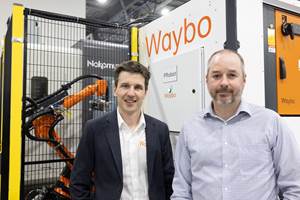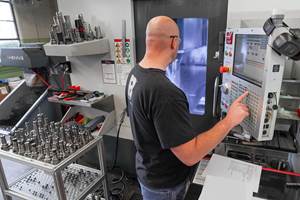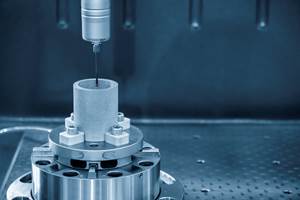Accuracy Achieved By Milling On A Magnet
Trilogy Systems ran into a major manufacturing hurdle as the length of its motors increased. The linear motor body comprises a U-section made up of three precision-machined mild-steel plates into which the magnets and coil assembly for the motor are installed.
Share





Trilogy Systems, a leading manufacturer of high accuracy linear motors used for positioning tables in the semi-conductor industry, ran into a major manufacturing hurdle as the length of its motors increased. The linear motor body comprises a U-section made up of three precision-machined mild-steel plates into which the magnets and coil assembly for the motor are installed. As motors became longer over the years, it became increasingly difficult to maintain accuracy using vises to fixture the steel plates. And with the acquisition of a new mill with the capability to machine motor bodies up to 120 inches in length, it became clear that the battle of fixturing in vises had been lost.
Bruce Beakly, President of Trilogy and chief engineer of the Trilogy linear motors, was aware of the holding power available from magnetic systems and turned to WEN Technology for assistance with a magnetic workholding system for his milling requirements. The solution chosen was a set of Bakker permanent magnetic chucks. Since the parts to be held were thin, it was imperative that a fine pole distribution be used so that the magnetic energy would be held within the part and not cause chip retention problems—which could cause damage to the milling cutters—or reduced holding power. For the linear motor bodies which have a finished thickness of approximately 0.25 inch, the Bakker Standard Pole series of permanent magnetic chucks provided the best combination of features: magnetic energy is held within the workpiece, a holding force of 116 psi is achieved, and thermal stability is maintained.
The choice of permanent magnet chucks for such a large milling table—12 by 120 inches—versus electro-magnetic chucks might at first appear rather unusual. However, the fine pole distribution, full magnetic saturation, ease of installation, reliability and thermal stability of the permanent magnet design proved to be clear deciding factors.
Another factor in machining the motor body components was to be able to machine the parts complete in one setup. In particular, it was necessary to mill both ends, all details on one face and drill through for assembly fastener access. Again, the magnetic solution proved highly versatile with a laminated wear plate used to support the part. Through drilling is accomplished by drilling into this disposable plate thus minimizing setups and helping to maintain accuracy.
"In the old days, we were quite good at setting up 24-inch motor plates in vises," said Production Manager Larry Floro. "But when it came time to set up 120 by 2 by 0.25 inch motor frame plates in vises, there was just no way. If we got it straight, it wasn't flat. If we got it flat, it wasn't straight. And if we could get it straight and flat, it wouldn't stay that way during machining.
"With the magnets, I have a disposable face plate which has been qualified to the machine," said Production Manager Larry Floro. "We can lay the plates down in sets, turn on the magnet and cut. Net result is a set of motor plates that are matched and within our manufacturing tolerances every time Any style, any size: just lay the plate down, load the program and cut."
For Trilogy Systems, the answer to reduced setup time and improved accuracy has proven to be magnetic chucks on their mills.
Related Content
Shop Doubles Sales with High-Mix, Low-Volume Automation
Robots with adaptive grippers have opened entire shifts of capacity to high-mix, low-volume shop Précinov, doubling its sales.
Read MoreFixtureworks Pneumatic Clamp Fasteners Reduce Setup Time
The product lineup includes ball-lock pneumatic fasteners, ID holding, pin holding single- and double-acting pneumatic clamping fasteners.
Read MoreMedical Shop Performs Lights-Out Production in Five-Axes
Moving to five-axis machining enabled this shop to dramatically reduce setup time and increase lights-out capacity, but success relied on the right combination of workholding and automation.
Read MoreParts and Programs: Setup for Success
Tips for program and work setups that can simplify adjustments and troubleshooting.
Read MoreRead Next
Machine Shop MBA
Making Chips and 91ÊÓƵÍøÕ¾ÎÛ are teaming up for a new podcast series called Machine Shop MBA—designed to help manufacturers measure their success against the industry’s best. Through the lens of the Top Shops benchmarking program, the series explores the KPIs that set high-performing shops apart, from machine utilization and first-pass yield to employee engagement and revenue per employee.
Read MoreAMRs Are Moving Into Manufacturing: 4 Considerations for Implementation
AMRs can provide a flexible, easy-to-use automation platform so long as manufacturers choose a suitable task and prepare their facilities.
Read More




















